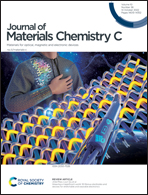Rational molecular design of phenanthroimidazole-based fluorescent materials towards high-efficiency non-doped deep blue OLEDs†
Abstract
Achieving high external quantum efficiency (EQE) for non-doped deep blue fluorescent organic light-emitting diodes (OLEDs) with the Commission International de I'Eclairage (CIE) coordinate of CIEy < 0.08 remains a big challenge. Herein, three high-efficiency molecules PPI-2-DMF, PPI-2-DPF and PPI-3-SBF with weak intramolecular charge transfer properties are successfully prepared by connecting phenanthroimidazole (PI) and various fluorene derivatives via benzene bridges. The crystallographic study confirms that only C–H⋯π weak intermolecular interactions exist in these crystals, which is conducive to obtaining high solid-state fluorescence efficiency, and eventually, the photoluminescence quantum yields (PLQYs) of PPI-2-DMF, PPI-2-DPF and PPI-3-SBF reach 57.56, 67.22 and 66.05%, respectively. PPI-3-SBF exhibits the shortest conjugation length among the three molecules, leading to the bluest emission. As a result, the non-doped device with PPI-3-SBF as an emitting layer realizes a high maximum EQE of 8.41% with CIE coordinates of (0.16, 0.07), accompanied by a relatively low efficiency roll-off. These findings would provide a new strategy of molecular structure design for highly efficient deep blue non-doped OLEDs.



 Please wait while we load your content...
Please wait while we load your content...